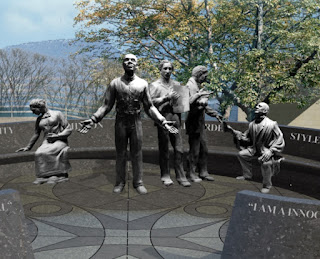The Ed Johnson Memorial in Chattanooga Tennessee
Jerome Meadows : The Ed Johnson Memorial (detail)
114 years before George Floyd was choked by a policeman in Minneapolis, Ed Johnson was lynched by a mob in Chattanooga. If there's been any noticeable improvement in race relations over that century , it would be that Floyd's death triggered a national discussion about policing and social injustice. The perpetrator was convicted of murder. The Johnson lynching, however, seems to have been just one more episode in the use of terror to dismantle Reconstruction and establish apartheid across the South. A few of the leading perpetrators, including the sheriff, were convicted of contempt of court and soon returned home as local heroes.
The above statuary group memorializes that event. With one foot on his noose, Johnson is shown as a spirit taking flight in front of the two African American attorneys shown behind him. They appealed his case and and got a stay of execution from the Supreme Court. Despite that success, however, Johnson was dragged from jail and hung from a bridge, while the offices of the two attorneys were later burned and they were forced to flee the state.
Belle Kinney Scholz : General Alexander P. Stewart, 1915
Nine years after the lynching, The Daughters of the Confederacy funded the installation of the above bust of a Confederate general in front of the very same county court house where Johnson was convicted by an all-white jury.
Not a very subtle message, was it ?
It's a fine statue - at least from this view. It was executed by one of the many female students of the great Chicago sculptor, Laredo Taft. Nearly 100 confederate statues were removed across the South in 2020 - and this should have been one of them. Its connection to lynching, racial injustice, and white supremacy is rather blatant. It certainly does not belong in front of a court house that should be dispensing equal justice to all. Regretfully, however, local authorities recently voted to keep it there.
"
So it's good that the community will now experience that injustice from another point of view.
This is a positive, uplifting, almost religious monument. Johnson steps on his noose just as a saint might present the weapons that martyred her. Their power has been defeated because spirit is immortal.
Jerome Meadows, the artist, does not specialize in figurative sculpture. This monument is unique in his oeuvre. But he is an inventive, thoughtful, and aesthetic creator. He saw what he needed to be done and he found the means to do it.
His three figures stand like a grove of trees - their legs rooted to the ground, their bodies rising up to the sky -- their arms gently swaying like branches in the wind. They are far more pleasant than the rather ugly old iron bridge beside it.
I would like to have seen more inner power in the heads - but these may be the first life size heads Meadows has ever modeled.
The back side of the monument leads down to the Tennessee River.
The see-through silhouetted standing figures recalls the Haitian folk sculpture cut from oil barrels.
One of the figures represents Johnson, the other represents Alfred Blount who was lynched there in 1893.
This is another one of the finalists for the memorial's design.
Presumably, the figurative relief was optional.
This was the third finalist
Likewise, the four other figures must have been optional
Having a taste for neither bombast nor cartoonish melodrama, I'm glad that Meadows won the competition.
He tells the story - but he also transcends it.
















0 Comments:
Post a Comment
<< Home